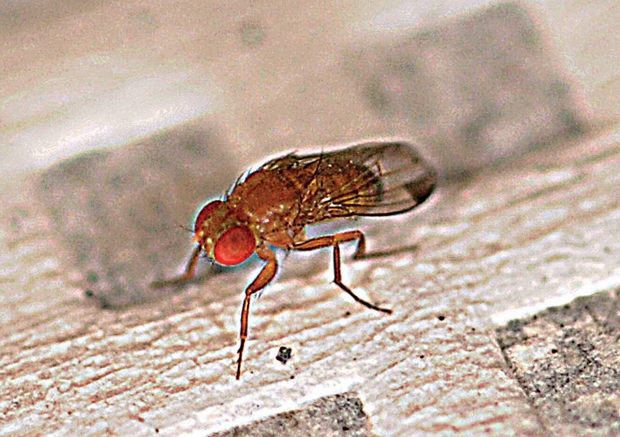
Spotted wing drosophila. (Courtesy Kathy Keatley Garvey, University of California, Davis)
Codling moth has been plaguing Washington State apple orchards for well over a century, and the only reason it might drop from its status as growers’ number-one pest is if a new invasive pest comes along, says Dr. Jay Brunner, director of Washington State University’s Tree Fruit Research and Extension Center in Wenatchee.

Jay Brunner, Washington Tree Fruit Research Commission. (TJ Mullinax/Good Fruit Grower)
“Brown marmorated stinkbug will make us quit worrying about codling moth because everyone will be focused on it,” he said.
Codling moth is well adapted to the dry eastern Washington environment. Even at low populations, the moths can easily find each other and mate, and they have a relatively high reproduction rate. The pest has no natural enemies that alone can keep it below levels where it causes significant economic losses in apple and pear.
For many years, growers resorted to a series of different pesticides to prevent codling moth injuring their apples. By the 1970s, they were typically applying the organophosphates Guthion (azinphos-methyl), Penncap (methyl-parathion), and Lorsban (chlorpyrifos).
Pesticide programs were cheap and effective, but scientists such as Drs. Stan Hoyt and Everett Burts at Washington State University and Peter Westigard at Oregon State University were working on a concept called integrated pest management, which involved considering the impacts of pesticides on beneficial insects and the environment.
Brunner, who was born in Pendleton, Oregon, graduated from Willamette University, Oregon, in 1969 with a bachelor’s degree in biology and went to WSU as a graduate student. After earning his doctorate in entomology at WSU in 1975, he took a research and extension position in tree fruit and small fruit IPM at Michigan State University.
Time of change
Three years later, when stone-fruit entomologist Ted Anton retired from WSU, Wenatchee, Brunner took his place, working alongside Hoyt and Burts, who were leaders in tree fruit IPM.
“It was a time of change,” he recalled, “and there was interest at the national level in IPM, driven a lot by concerns over the negative effects of pesticides on the environment and on agriculture, so there was funding for those types of programs.”
In 1989, Brunner took a sabbatical in Switzerland, where he worked with entomologist Dr. Pierre Charmillot, who had been experimenting with putting rubber tubes containing codling moth pheromone out in orchards. The idea was to put enough pheromone out in the orchard to confuse the males so they couldn’t find females and mate.
“I thought it was an interesting technology, but there was obviously a lot to learn,” Brunner reflected.
The first commercial pheromone dispensers for codling moth came onto the U.S. market in 1991. It was not just growers who were skeptical about this new nonkill strategy.
“I think there was even skepticism on our part,” Brunner said. “I think that’s a good approach for a scientist to be skeptical about new technology and to challenge it.”
Working with Dr. Larry Gut, then a postdoc at WSU, he conducted three years of trials in commercial orchards and found that if beginning codling-moth pressure was high, relying only on mating disruption (pheromones) alone was not sufficient, and fruit injury increased. But, if pressure was low, mating disruption worked well.
Mating disruption was conceived as a foundational tool for a codling moth management program, not a standalone product, which meant that supplemental pesticide applications would be needed where pest pressure was moderate to high. And the dispensers were relatively expensive.
“In 1990, most of the pesticides cost $20 to $30 per acre, so they were pretty cheap,” Brunner said. “When you added $100 per acre for one pest and one product—even though it lasted the entire season—it was a challenge.”
The Food Quality Protection Act of 1996, which mandated the review and reregistration of all pesticides, beginning with organophosphates, was an impetus for growers to consider alternatives.
Although growers feared the loss of traditional pesticides, Brunner said that ultimately, FQPA had some positive effects. It stimulated private industry to develop new products and tools that were less detrimental to beneficial insects, the environment, and human health.
It heightened the emphasis on IPM and promoted the replacement of broad-spectrum insecticides with newer, more selective products. And this led to more stable programs that take a longer-term view of pest management, rather than just responding to the immediate problem with a spray.
WSU helped growers transition to softer codling moth programs. Today, mating disruption is used on 85 to 90 percent of Washington’s bearing apple acreage, Brunner estimates, but scientists are still working on better ways to control the pest.
For example, Dr. Steve Garczynski, with the U.S. Department of Agriculture in Yakima, Washington, is working on ways to block the male codling moth’s ability to detect the females’ pheromones with its antennae. Males would then have difficulty locating females even without additional pheromones being applied.
Decision Aid System
In recent years, Dr. Vince Jones at WSU has been leading efforts to enhance biological control. Predictive models for pests have been available for decades, but he’s developing predictive models for natural enemies so growers can figure out when they’re active in the orchard and time sprays to avoid harming them.
Jones is director of WSU’s free online tree fruit Decision Aid System (DAS) that provides degree-day models and pest management recommendations, along with real-time weather information and forecasts. It also provides access to basic information on the biology and identification of pests and natural enemies.
It’s all part of an effort by WSU scientists to understand how new technologies work—whether pheromones or pesticides—and help the industry to use them properly so growers are able to produce a high-value crop more safely with minimal inputs, Brunner said.
A large proportion of Washington growers are using DAS, and all their field horticulturists and consultants are, so 100 percent of the tree fruit growers in the state are benefitting from it.
Brunner thinks that, in the long run, the best way to defeat codling moth would be to develop apple varieties that are resistant to attack. WSU scientists are already working to identify cultivars that seem less appealing to codling moth and leafrollers. If resistance genes can be identified, there might be a way to more rapidly incorporate resistance into new cultivars without using genetic engineering.
“I think resistance is probably the HolyGrail,” Brunner said. “It’s a very difficult thing to imagine that you would find resistance for all pests.
“The biggest concern I have is new and exotic pests where we don’t necessarily have controls,” he added, noting that global trade increases the risks of insects traveling to new destinations, not necessarily on crops, but in shipping materials, for example.
The arrival of spotted wing drosophila as a cherry pest in the Pacific Northwest four years ago has forced growers to switch from a soft program for cherry fruit fly, using the GF-120 bait, to more contact pesticides and is adding to their expenses.
“The brown marmorated stinkbug’s impact on all crops is a similar story, and I think it could really set our IPM programs back many years if we had to revert to using broad-spectrum contact insecticides,” he said. “The arrival of new diseases or insects I think will drive a lot of what happens in pest management over the next decades.” •






Hi Jay, we too in Australia are having similar issues. Now that our native fruit fly Bactrocera tyroni Queensland fruit Fly is declared endemic in south eastern Australian fruit producing areas, and WFt is an on going problem, we see mating disruption in decline in favor of insecticides more for secondary pests than Primary pests.
Are are also about to see a cutback in funding in our Biosecurity areas. This will no doublt lead to entry of pests that would otherwise be detected. I am afraid it will be a similar situation to the US after 911 when the focus was more on other detectables than exotic pests. Now the US is paying the price, Australia will be a few years behind so we have the fortunate (?) grace of being able to learn forum your experiences.
Regards Russell Fox